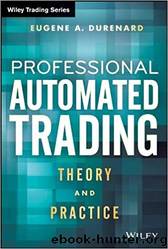Professional Automated Trading: Theory and Practice (Wiley Trading) by Eugene A. Durenard

Author:Eugene A. Durenard [Durenard, Eugene A.]
Language: eng
Format: epub
Amazon: B00FO4WZFA
Publisher: Wiley
Published: 2013-10-03T16:00:00+00:00
For example, the AGRESSOR algo encountered in Chapter 10 was built exactly on the above principle of feedback. The desired state is a certain market position, the current state is the actual position, and the control mechanism is to issue an order quantity for the difference between the two. When executions come, either the desire is fulfilled, or there is a shortfall and another order is emitted recursively to cover the shortfall.
In a device, like a thermostat, the goal is very clear and so is the mechanism. Even filling a sink involves feedback: There is a source with a tap, a sink with a plug, and someone tells us the amount of water needed. Easy.
But now take a trading strategy. What is its goal? It is to make money. There is a sink where it can lose money, so it needs to implement a plug. Its decision-making mechanism may be a source, but it is an uncertain, leaky tap that can sometimes pour money straight down the sink hole. Although the principle of feedback is very intuitive, it is not always obvious how to pose the problem correctly in order to implement it efficiently.
My stance is that capital preservation is a primary goal in trading, and capital growth is second in line. Of course, there is no free lunch, and there is no growth without risk. One has to pay to play, but one also needs to be able to stay in the game long enough in order to have a chance to win. Managing downside risks relative to potential gains should be the guiding principle for a successful and robust trading business.
Given that the ultimate goal of the strategy is to make money, and that the strategy needs some breathing space to take risks, how then one is to measure the distance between the actual and the desired state? Is the strategy achieving its goal?
Herein lies part of the problem, but also part of the solution. It is the vagueness in the definition of external state that lies at the root of the difficulty in designing the control loop.
In the discussion regarding the swarm paradigm of adaptation, on what basis would the CIO decide to reallocate risk from a trader who underperforms to a trader who performs better? Is it with a concrete performance goal in mind or a certain benchmark?
From the questions above, the intuition arises that the concept of the external state of a strategy is related to some criterion that measures its behavior. To implement the adaptation feedback loop one then would need to understand how far the current behavior deviates from the desired behavior. A numeric criterion that measures the behavior of a decision-making strategy is called a fitness measure.
The concept of fitness comes from the evolutionary ideas of Darwin and Lamark, and was formalized when genetic algorithms were introduced into computer science in the 1960s. Ranking simulated organsims by fitness provides a numeric selection criterion that helps retain the best subset of the population at each genetic algorithm iteration.
Download
This site does not store any files on its server. We only index and link to content provided by other sites. Please contact the content providers to delete copyright contents if any and email us, we'll remove relevant links or contents immediately.
| Analysis & Strategy | Bonds |
| Commodities | Derivatives |
| Futures | Introduction |
| Mutual Funds | Online Trading |
| Options | Portfolio Management |
| Real Estate | Stocks |
Pioneering Portfolio Management by David F. Swensen(5616)
Rich Dad Poor Dad by Robert T. Kiyosaki(5167)
How To Win Friends and Influence People by Dale Carnegie(3780)
The Money Culture by Michael Lewis(3293)
The Dhandho Investor by Mohnish Pabrai(3176)
The Wisdom of Finance by Mihir Desai(3087)
Liar's Poker by Michael Lewis(2821)
The Intelligent Investor by Benjamin Graham Jason Zweig(2602)
The ONE Thing by Gary Keller(2530)
Mastering Bitcoin: Programming the Open Blockchain by Andreas M. Antonopoulos(2520)
Investing For Dummies by Eric Tyson(2477)
How to Day Trade for a Living: Tools, Tactics, Money Management, Discipline and Trading Psychology by Andrew Aziz(2454)
How to Win Friends and Influence People by Dale Carnegie(2443)
Rich Dad Poor Dad: What The Rich Teach Their Kids About Money - That The Poor And Middle Class Do Not! by Robert T. Kiyosaki(2439)
Fooled by Randomness: The Hidden Role of Chance in Life and in the Markets by Nassim Nicholas Taleb(2421)
Zero Hour by Harry S. Dent Jr. & Andrew Pancholi(2251)
Market Wizards by Jack D. Schwager(2170)
Rich Dad's Guide to Investing by Robert T. Kiyosaki(2117)
How to Pay Zero Taxes, 2018 by Jeff A. Schnepper(2106)
